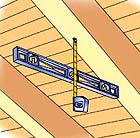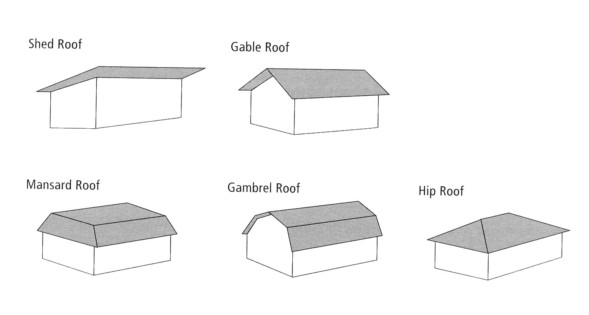To determine how many roofing
squares you need for your project, enter the measurements—rounded
to the nearest foot—into our pop-up calculator. A 10 percent
waste allowance is automatically added to the total.

Tips on Measuring for Roofing
To accurately calculate the area of your roof, you must first
determine its slope, or pitch. Roof pitches are described in
terms of rise and run. The run is the distance from the outside
edge of a perimeter stud wall to the center of the house. The
rise is the distance from the top of a stud wall to the peak
of the roof. A roof’s pitch is determined by how much it
rises for every foot it runs. Thus, a moderate 6 in 12 roof
pitch means the roof rises 6 inches for every 12 horizontal
inches it runs. A 12 in 12 pitch is a steep, 45-degree angle
roof.
Roof Pitch
Use one of these three methods to calculate your roof’s
pitch. You’ll need a level and a tape measure or ruler.
Mark a spot on the bottom of the level, 12 inches from one end.
Roof Area
Flat Roofs
If your roof is flat or has no more than a 3 in 12 pitch,
you can calculate its total square footage by simply multiplying
the length by the width.
Steeper Roofs
Measure your house at ground level, then add in the roof’s
overhang for greater accuracy. As an example, if the roof overhang
is 12 inches, you’ll add 2 feet to the overall length and
2 feet to the overall width of the house. This nominal square
footage amount is then multiplied by a factor associated with
the roof’s pitch. (Note: These factors are listed to the
right for your reference. They will be integrated into the calculator
when you provide your roof pitch selections.) Pitch Multiply
by:
4 in 12 1.06
5 in 12 1.08
6 in 12 1.12
7 in 12 1.16
8 in 12 1.20
9 in 12 1.25
10 in 12 1.30
11 in 12 1.36
12 in 12 1.42
|
1. On a ladder beside the roof, place
the level a foot or so up the roof, hold
it level, and measure from the 12-inch mark on the bottom
straight down to the roof. If
it measures 4 inches, you have a 4 in 12 pitch;
8 inches and you have an 8 in 12 pitch.
|
| 2. On a ladder at
the gable end of your house, place the level against the
rake rafter (the one on the roof overhang) with the 12-inch
mark on the rafter’s bottom
edge. Now measure from the end of the level up
to the bottom edge of the rafter. That is the roof’s
rise. |
| 3. In the attic,
place the level against a rafter with the 12-inch mark on
the bottom of the rafter. Measure
from the end of the level up to the bottom
edge of the rafter. That is the roof’s rise. |







